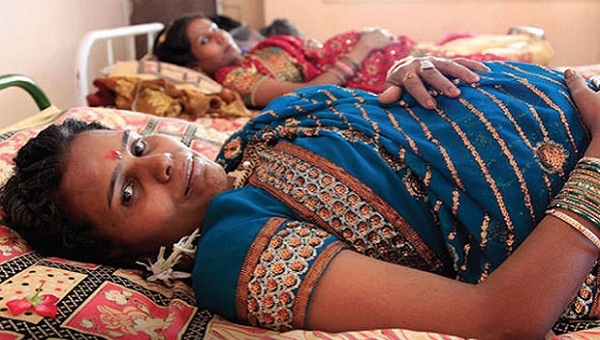
Prime Minister Narendra Modi, in his address to the nation on December 31, 2016, announced that Rs 6,000 will be transferred directly to the bank accounts of pregnant women who undergo institutional delivery/and vaccinate their children. He said it was a new scheme.
- The scheme will provide financial aid of Rs 6,000 to pregnant women who undergo institutional delivery for hospital admission.
- The sum is also meant to help with their child’s vaccination, as well as nutritional food.
- The scheme will be floated across 650 districts of the country.
- The money will be directly transferred to the bank accounts of pregnant women.
- The scheme is aimed at encouraging institutional deliveries in order to reduce maternal as well as infant mortality.
New Version of an Old scheme?
- Such a scheme—the Indira Gandhi Matritva Sahyog Yojana (IGMSY) was commenced by the UPA 2 government in October 2010 on a pilot basis in 53 districts. The National Food Security Act, 2013, made it incumbent upon the incoming NDA government to ensure universal coverage under the scheme.
- In an affidavit filed before the Supreme Court in October 2015, the Ministry of Women and Child Development (WCD) said the scheme would be extended to all districts, beginning with 200 districts in 2016-17. That commitment has not been met.
- Several civil society organisations have estimated the annual budgetary requirement for universal coverage under the scheme at Rs 16,000 crore. As against this, in 2016-17, Finance Minister made a total allocation of only Rs 17,408 crore for the entire Ministry.
Provisions of IGMSY?
- It is a conditional cash transfer scheme applicable to pregnant and lactating women of ages 19 and above for up to 2 living children.
- The scheme originally provided Rs 4,000 to each beneficiary through her Anganwadi centre, in all districts selected for the pilot project.
- All women are eligible, unless they have already received paid leave and maternity benefits from their employers in the private or government sector.
- The scheme is aimed at arresting high maternal mortality rates by encouraging institutional delivery and ensuring proper nutrition for the mother and child.
- It is also meant to offset wage losses suffered by women due to pregnancy, and is especially important for women in the unorganised sector, who make up 90% of the country’s female workforce.
- Fear of losing wages often forces women in the informal sector to work through pregnancy and immediately thereafter, to the detriment of their and their babies’—who require at least 6 months of regular breastfeeding—health.
Not Universal One
Section 4 (b) of the National Food Security Act, which came into force on September 10, 2013, states that every pregnant and lactating mother would be entitled to “maternity benefit of not less than Rupees six thousand”. On September 27 that year, the maternity benefit under the IGMSY was enhanced to Rs 6,000 in the 53 districts where it was ongoing. But universal implementation was not supported by commensurate Budget allocations. In 2015, PUCL went to Supreme Court against the flawed implementation of the Food Security law. Among other things, it pointed to the non-implementation of Section 4 (b).
- Tamil Nadu is currently the only state that provides universal cash assistance to Below Poverty Line pregnant women: Rs 12, 000 in 3 instalments under the state government’s Muthulakshmi Reddy Maternity Benefit Scheme.
- At 20 deaths per 1,000 live births, Tamil Nadu has the lowest infant mortality rate after Kerala and, at 79 maternal deaths per 100,000 live births, among the lowest maternal mortality rates in the country.
Need of Universal Maternity Benefit Scheme
- India’s maternal and infant mortality indicators are very poor. Every third woman is undernourished and every second woman is anaemic, government statistics show. An undernourished woman would likely give birth to a low-weight baby.
- As per the UN Millennium Development Goals Report 2014, India recorded the highest number of maternal deaths in the preceding year, and accounted for 17% of global deaths due to pregnancy- and childbirth-related complications (some 50,000 of 2.89 lakh such deaths worldwide).
Implementation of PM’s Announcement
- The WCD Ministry has said it will release Rs 6,000 in 3 instalments for the first 2 live births—Rs 3,000 during the first trimester following early registration of pregnancy and one antenatal check-up, Rs 1,500 at the time of institutional delivery, and Rs 1,500 three months later, after the child is administered the necessary vaccination.
- The Ministry estimates that 51.70 lakh women will be benefitted annually. States will have to bear 40% of the cost, and the Centre will provide the rest. The Ministry conservatively estimates the scheme to require a total Rs 7,932 crore until 2019.
Will the Scheme Achieve its Intended Purpose?
- The Ministry is yet to issue the fine print of the policy’s implementation. But it has retained the condition that the woman must not have more than 2 living children.
- A study by the National Alliance for Maternal Health and Human Rights has shown that this precondition excludes 60% of women in the 15-49 age group, most of whom are Dalits and tribals, and a majority of whom have 3-7 pregnancies—which further affects their health. Several civil society organisations have asked for such conditions to be removed so that the scheme could be truly effective.
The PM’s announcement assumes significance as India accounts for 17% of all maternal deaths in the world. The country’s maternal mortality rate is pegged at 167 per 100,000 live births, whereas infant mortality is estimated at 43 per 1,000 live births. Among the primary causes of high maternal and infant mortality are poor nutrition and inadequate medical care during pregnancy and childbirth.